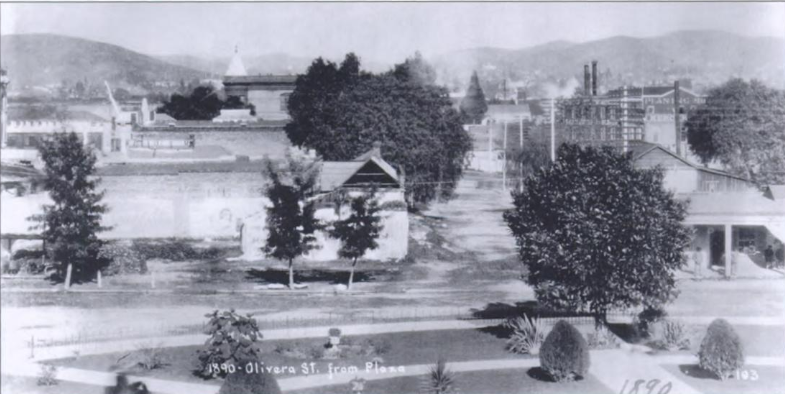As a tourist attraction, Olvera Street has its roots in the late 1920s, when Christine Sterling began a fundraising quest to save Avila Adobe. The oldest standing residence in Los Angeles had been slated for demolition. Her dream expanded to include all of Olvera Street, hoping to restore it to its original Mexican and Spanish heritage. Many of the original buildings were saved in the process, and craftspeople and artists opened businesses along the street, creating a place for visitors to learn about the early history of Los Angeles.

The Historical Origins of Olvera Street
The real history of Olvera Street began with a pueblo built by 44 settlers in 1781. The homes, which were owned by Californios, included Avila Adobe, built in 1818 by wealthy cattle rancher Francisco Avila. The early 1800s Mexican pueblo became the seed of growth for American Los Angeles following the Mexican-American War. Floods, earthquakes, war, the Great Depression, racially inspired deportations, neglect, and restoration have all left their marks on Olvera Street and Plaza.
Today, over two million visitors are drawn each year to what is now designated the El Pueblo de Los Angeles Historical Monument. To understand the raw historical truth of the birthplace of Los Angeles, William Estrada, historian and curator of the Historical Monument, has written a book called Los Angeles’s Olvera Street that is packed with an astonishing collection of vintage photos and historical information.
Docents from Las Angelitas lead free 50 minute walking tours through El Pueblo de Los Angeles Tuesdays through Saturdays. Visitors who’ve read the book will have a deeper appreciation of some of the highlights on the tour, like Avila Adobe, La Iglesia de Nuestra Senora La Reina de Los Angeles (The Church of Our Lady Queen of the Angels), Pico House owned by Pio Pico – the last Mexican Governor of California, Sepulveda House, El Kiosko (Olvera Street Plaza), Firehouse #1, and many of the other 27 historically significant attractions.
Sights, Smells, and Sounds of El Pueblo de Los Angeles
Olvera Street offers not only a glimpse into the Mexican history of El Pueblo del Los Angeles, but it provides a cultural immersion where visitors can shop, dine, listen to music, and attend festivals and events. It’s a place to visit again and again. Situated near both Union Station and a reasonably priced parking pay lot, visitors have easy access to the historic area.
Shopping
Stroll down the two blocks of Olvera Street, the birthplace of Los Angeles, and experience the same sights, sounds, and aromas you would if you walked down the street of any tourist town in Mexico. Shiny ceramic avocados, peppers, onions, and other vegetables hang from decorative rope next to strings of hanging gourd maracas painted green, white, and red. Brightly colored ukuleles, skulls, and smiling suns occupy space alongside decorative sombreros, blankets, leather flower coin purses, and lucha libre masks. Mexican vanilla, coffee, chocolate, and hot sauces fill shelves near myriad Mexican artisan tchotchkes. This pedestrian street, the historic heart of Los Angeles, is alive with color.
Dining
Mexico is a big country with regional cuisine specialties throughout, so Mexican food can mean a lot of different things. On Olvera Street there are about ten restaurants and a few stands and cafés to represent all of Mexico. Expect to find Olvera Street by following your nose! You can experience aromatic and delectable traditional Mexican fare like mole poblano, caldo 7 mares (7 seas soup), enchiladas, and fajitas.
Stop by a casual eatery for tasty taquitos with avocado tomatillo sauce and house horchata or steaming carne asada fries. For a yummy snack, get a dulce le leche churro fried and filled with warm caramel, then dusted with cinnamon and sugar at Mr. Churro. If you’d like to know a little something about Mexican food in Los Angeles before you go, check out the book Los Angeles Street Food: A History from Tamaleros to Taco Trucks by LA food writer Farley Elliott.
Music
Not only is the air filled with the scents of savory Mexican dishes and sweet fried churros, it is also filled with the sounds of Mariachi music. A traditional Mariachi group has various stringed instruments like violin, Spanish guitar, vihuela (a high-pitched five string guitar), and guitarròn (acoustic bass), along with trumpets. Sometimes there are other instruments – accordion, for example, and at times, if it is a small roving street group, there will be only one of each instrument. Music is generally traditional folk music. Some mariachis will be in restaurants, and others will be on the street. It is appropriate to tip if you stop to enjoy the music.
Olvera Street is also home to several cultural events, fiestas, and celebrations throughout the year. Check their website to see what’s happening during your visit, or plan to attend a particular event. Reading up on the area before your visit will enhance your experience and make it more memorable.

